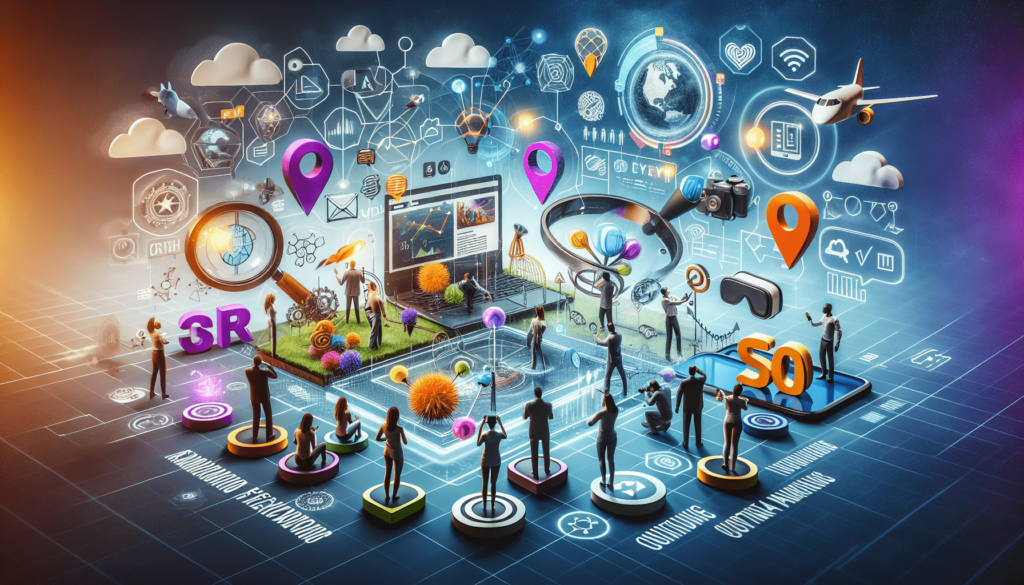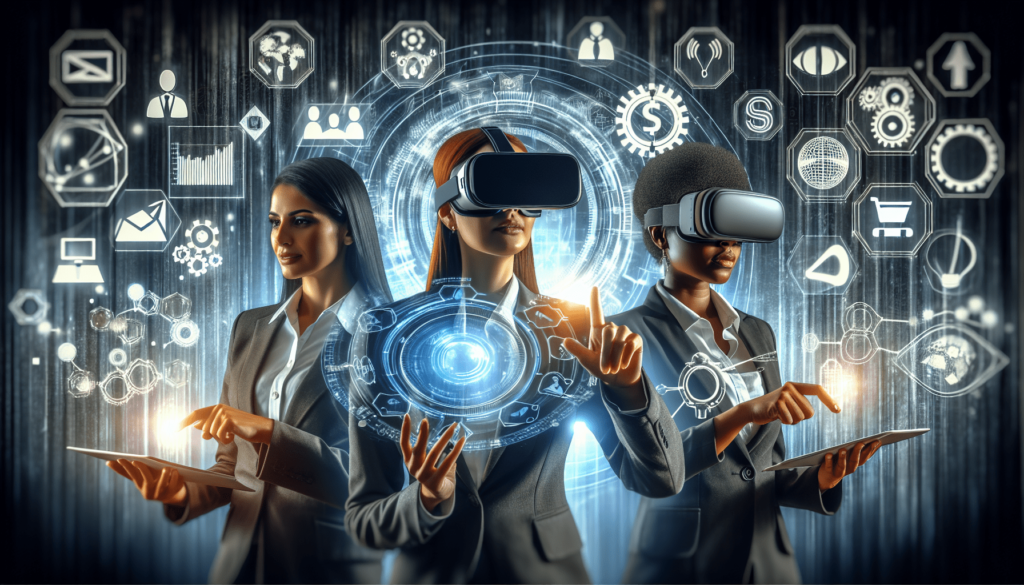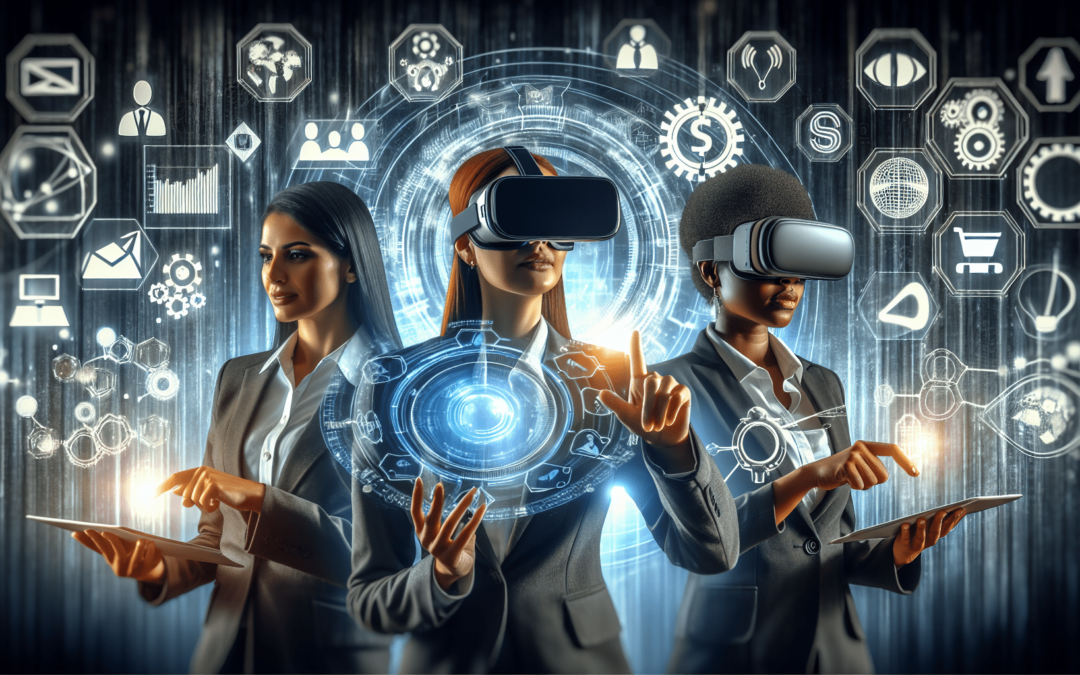In the fast-paced digital world, it is crucial for businesses to stay ahead of the curve when it comes to content marketing SEO. And one way to do just that is by harnessing the power of augmented reality (AR) and virtual reality (VR). These cutting-edge technologies have revolutionized the way consumers engage with content, immersing them in interactive experiences like never before. By incorporating AR and VR into your content marketing strategy, you can captivate your audience, boost engagement, and ultimately drive more traffic to your website. So, let’s take a closer look at how AR and VR can impact content marketing SEO and help your business thrive in the age of digital innovation.

Introduction to AR and VR
Definition of augmented reality (AR)
Augmented reality (AR) refers to the technology that overlays digital information and virtual objects onto the real world. It enhances the user’s perception of reality by superimposing computer-generated images, videos, or 3D models onto the physical environment.
Definition of virtual reality (VR)
Virtual reality (VR) is a simulated experience that can be similar to or completely different from the real world. It immerses the user in a computer-generated environment, typically through the use of a headset or goggles, providing a sense of presence and interaction in a virtual world.
Brief history and development of AR and VR
AR and VR have come a long way since their inception. The concept of VR dates back to the 1960s, when Ivan Sutherland developed a head-mounted display, known as “The Sword of Damocles.” However, the commercial applications of VR were limited until recently.
AR, on the other hand, gained popularity in 2016 with the release of Pokémon Go, a mobile game that allowed users to catch virtual creatures in the real world. This sparked widespread interest in the potential of AR technology.
In recent years, both AR and VR have seen significant advancements in technology and have been adopted in various industries, including content marketing. Businesses are increasingly recognizing the value of AR and VR in engaging their audience and delivering immersive experiences.
Understanding Content Marketing SEO
Definition of content marketing SEO
Content marketing SEO refers to the practice of optimizing content to improve its visibility and rankings in search engine results pages (SERPs). It involves the strategic use of keywords, high-quality content creation, and other SEO techniques to attract organic traffic and generate leads.
Importance of content marketing SEO for businesses
Content marketing SEO is crucial for businesses to succeed in the digital landscape. By optimizing their content, businesses can ensure that their target audience can find and engage with their brand easily. It helps drive targeted traffic to their website, increases brand awareness, and establishes thought leadership in the industry.
Key elements and strategies of content marketing SEO
Effective content marketing SEO involves several key elements and strategies. These include:
- Keyword research: Identifying relevant keywords and incorporating them strategically into the content.
- High-quality content creation: Producing valuable, informative, and engaging content that aligns with the target audience’s needs and interests.
- On-page optimization: Optimizing elements such as page titles, headings, meta descriptions, and URLs to improve visibility in search results.
- Link building: Acquiring high-quality backlinks from reputable websites to improve search engine rankings and domain authority.
- User experience optimization: Ensuring that the website is user-friendly, mobile-responsive, and provides a seamless browsing experience.
Emergence of AR and VR in Content Marketing
Integration of AR and VR in content marketing strategies
AR and VR have revolutionized content marketing strategies by offering unique and immersive experiences to users. Brands are integrating AR and VR technologies into their content marketing campaigns to engage their audience in innovative ways. For example, AR can be used to create interactive product catalogs that allow users to visualize and explore products in their own space.
Benefits of using AR and VR in content marketing
The use of AR and VR in content marketing brings several advantages to businesses. These include:
- Enhanced user engagement: AR and VR content captures the attention of users, providing them with a more immersive and interactive experience than traditional forms of content.
- Increased brand awareness: By delivering memorable and unique experiences, AR and VR content helps increase brand recall and visibility.
- Improved customer understanding: AR and VR can be used to showcase product features, demonstrate usage, and provide virtual tours, allowing customers to make more informed purchasing decisions.
- Competitive differentiation: Brands that embrace AR and VR in their content marketing strategies stand out from their competitors, as these technologies are still relatively novel and can create a “wow” factor.
Examples of AR and VR used in content marketing campaigns
Numerous brands have already successfully integrated AR and VR into their content marketing campaigns. For instance, Ikea introduced an AR app that allows users to virtually place furniture in their homes to see how it fits. This not only helps customers visualize their potential purchases but also enhances their online shopping experience.
Another notable example is the New York Times’ VR content, which provides immersive storytelling experiences to its readers. Through VR documentaries, users can explore different locations and engage with the story on a deep level, creating a powerful emotional connection.

Enhancing User Experience with AR and VR
Improving engagement and interaction with AR and VR
AR and VR have the power to significantly enhance user engagement and interaction. By allowing users to interact with virtual objects and environments, these technologies create a heightened level of engagement that traditional content cannot achieve. For instance, an AR-powered mobile app can enable users to point their device at a printed advertisement and unlock additional content, such as videos or interactive games.
Personalization and customization through AR and VR
AR and VR also enable personalization and customization in content marketing. Brands can leverage these technologies to tailor experiences according to individual preferences and demographics. For example, an AR shopping app can recommend personalized product suggestions based on the user’s browsing history and preferences, providing a more personalized and relevant shopping experience.
Creating immersive storytelling experiences with AR and VR
AR and VR offer unprecedented opportunities for storytelling in content marketing. They allow brands to immerse their audience in narratives, transporting them to different places and times. For instance, travel companies can use VR to offer virtual tours of destinations, enabling users to explore and experience different locations before making a booking decision. This creates a more compelling and memorable storytelling experience, fostering a deeper connection between the audience and the brand.
SEO Impact of AR and VR in Content Marketing
Increased website traffic and visibility
By integrating AR and VR into content marketing strategies, businesses can attract a larger audience and increase website traffic. The novelty and interactive nature of AR and VR content often lead to increased sharing and referrals, driving organic traffic to a website. Moreover, search engines recognize the value of unique and engaging content, which can result in improved visibility and higher search rankings.
Improved user engagement metrics
AR and VR content can significantly impact user engagement metrics such as time on page, bounce rate, and click-through rates. These technologies provide a more immersive and interactive experience, keeping users engaged for longer periods and reducing early exits from a website. As a result, search engines interpret this positive user behavior as a signal of high-quality content, potentially leading to improved search rankings.
Enhanced conversion rates and sales through AR and VR
AR and VR can have a substantial impact on conversion rates and sales for businesses. By providing users with an immersive and interactive experience, these technologies can instill a sense of confidence and trust in potential customers. For example, an AR visualization of a product can help users make more informed purchasing decisions, reducing doubts and boosting conversion rates. Moreover, the ability to showcase products in innovative ways can increase upselling and cross-selling opportunities, leading to higher sales volumes.
Optimizing AR and VR Content for SEO
Keyword research and optimization for AR and VR content
Keyword research and optimization remain crucial aspects of SEO, even for AR and VR content. Brands must identify relevant keywords and incorporate them naturally into their AR and VR content. This includes optimizing titles, descriptions, and captions to improve the visibility of the content in search engine results.
Optimizing meta tags, alt text, and descriptions
In addition to keyword optimization, brands should optimize meta tags, alt text, and descriptions for their AR and VR content. This helps search engines understand the context and relevance of the content, making it more likely to appear in relevant search results. Brands should ensure that meta tags accurately describe the AR and VR experience while incorporating relevant keywords.
Structured data markup for AR and VR content
Structured data markup adds another layer of optimization for AR and VR content. By implementing schema markup, brands can provide search engines with additional information about their content, such as the type of AR or VR experience offered, the industry, or the target audience. This allows search engines to display rich snippets and enhanced search results, improving the visibility and click-through rates for the content.
AR, VR, and Social Media Integration
Utilizing AR and VR on social media platforms
Social media platforms present a valuable opportunity for brands to integrate AR and VR content into their marketing strategies. For example, Facebook and Instagram offer AR filters and effects that users can apply to their photos and videos, providing an interactive and engaging experience. Additionally, Snapchat’s popularity with AR-powered lenses demonstrates the potential for brands to create engaging content in a social media context.
Driving social media engagement through AR and VR
AR and VR content can drive social media engagement by encouraging users to interact and share their experiences. Brands can create AR and VR experiences that align with their social media marketing campaigns, inspiring users to like, comment, and share the content with their followers. This social engagement amplifies the brand’s reach and visibility, potentially leading to increased website traffic and conversions.
Creating viral campaigns with AR and VR
AR and VR have the potential to create viral campaigns that generate widespread attention and engagement. Brands can leverage the novelty and interactive nature of these technologies to create unique and memorable experiences that users are eager to share. Viral campaigns can significantly expand a brand’s reach, attract new customers, and create a buzz around the brand’s offerings.
Challenges and Limitations of AR and VR in SEO
Technical obstacles and limitations
Implementing AR and VR in content marketing SEO comes with technical challenges. Brands need to ensure that their websites or applications can handle the bandwidth requirements and technical specifications of AR and VR content. Moreover, compatibility issues with different devices and operating systems can limit the reach and accessibility of the content.
Cost implications of implementing AR and VR
AR and VR technologies often require significant investments in hardware, software, and development resources. Implementing these technologies in content marketing strategies can involve substantial costs, particularly for small or medium-sized businesses with limited budgets. Cost considerations should be taken into account when deciding whether AR and VR are viable options for a business’s marketing goals.
Accessibility concerns and potential exclusion of users
AR and VR content may present accessibility challenges for users with disabilities or limited access to compatible devices. Brands should be mindful of the potential exclusion of certain user groups and strive to create inclusive experiences. Providing alternative content formats or options for users who cannot access AR and VR can help ensure a seamless experience for all users.
Future Trends of AR, VR, and Content Marketing SEO
Advancements in AR and VR technology
The future of AR and VR in content marketing SEO holds great promise. Advancements in technology, such as faster internet speeds, improved graphics capabilities, and more affordable hardware, will make AR and VR more accessible and seamless. This will enable brands to create even more immersive and engaging experiences for their audience.
Integration of AI and machine learning with AR and VR
AI and machine learning are expected to play a significant role in the integration of AR and VR into content marketing. These technologies can enhance personalization, recommendation systems, and user feedback based on AR and VR interactions. By analyzing user behavior and preferences, AI-powered systems can provide more tailored and relevant AR and VR experiences.
Potential impact of AR glasses and wearable devices on SEO
The rise of AR glasses and wearable devices is likely to have a substantial impact on SEO and content marketing. As these devices become more widespread, they will offer new opportunities for brands to deliver AR and VR content directly to users. This will require optimization strategies specifically tailored for AR glasses and wearable devices, ensuring that brands can reach their audience effectively through these platforms.
Conclusion
Summary of the impacts of AR and VR on content marketing SEO
AR and VR have significantly impacted content marketing SEO by providing immersive, interactive, and personalized experiences for users. These technologies have improved user engagement, increased brand awareness, and enhanced conversion rates and sales. Incorporating AR and VR into content marketing strategies can drive website traffic, improve user engagement metrics, and ultimately contribute to a successful SEO strategy.
Key takeaways for businesses and marketers
Businesses and marketers should consider the following key takeaways when leveraging AR and VR in content marketing and SEO:
- Embrace the immersive power of AR and VR to create unique and engaging experiences for your audience.
- Optimize AR and VR content for search engines by conducting keyword research, optimizing meta tags, and implementing structured data markup.
- Leverage the opportunities presented by social media platforms to integrate AR and VR into your marketing campaigns and drive engagement.
- Be aware of the technical challenges, cost implications, and accessibility concerns associated with implementing AR and VR.
- Stay updated with the latest advancements and trends in AR, VR, and SEO to keep your content marketing strategies relevant and effective.
Importance of staying updated with AR, VR, and SEO trends
The landscape of AR, VR, and SEO is constantly evolving. Staying up to date with the latest trends, technologies, and best practices is essential for businesses and marketers seeking to leverage the power of AR and VR in their content marketing SEO strategies. By staying informed and adapting to these trends, businesses can stay ahead of the competition and deliver compelling and immersive experiences to their audience.


